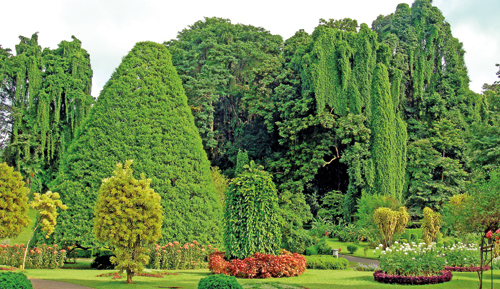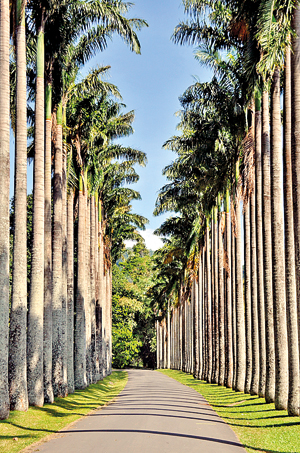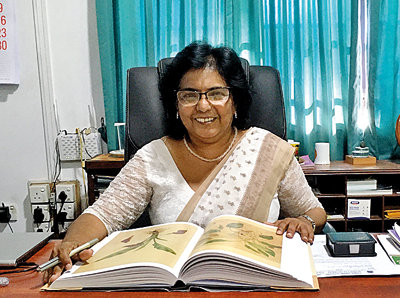200 years ago a green haven began to grow

Green and still growing: One of Peradeniya’s beautiful vistas. Pix courtesy Royal Botanic Gardens Peradeniya
The Royal Botanic Gardens Peradeniya, beloved to Lankans and known simply as the Peradeniya Gardens celebrates a rare milestone on February 21 – its bicentenary. Founded by the British as a premier research institution for agriculture and plantation crops in the country, it was brought under the purview of the Department of Agriculture and in 2006, the Department of National Botanic Gardens was formed to administer this and other botanic gardens around the island.
Immersed in planning a packed calendar of people-friendly events is Dr. Shelomi Krishnarajah, the seventh Sri Lankan Director General of the Gardens and the first woman to hold this post. Dr Krishnarajah who was appointed in 2018 has a solid background in floriculture and tissue culture.
Speaking to the Sunday Times of the long history and future plans for the Gardens, she says they have a year-long programme with many events to celebrate the bicentenary (please see box story) including a new Museum to be opened this April for visitors keen on exploring the Gardens’ history and many facets.

Stately: Avenue of Royal Palms
The history of the Royal Gardens could be traced back to the 1300s when King Wickremabahu III ascended the throne and had his court near the Mahaweli River in Peradeniya. King Kirti Sri Rajasinha (1747- 1780) made this area his Royal Garden. Later, King Rajadhi Rajasinha (1780-1798) resided in a temporary residence built for him in Peradeniya.
During the reign of King Wimaladharmasuriya, a vihara was also built where a monk was in residence but these were destroyed when the British occupied Kandy. The famous Gannoruwa battle between King Rajasinha II and the Portuguese was fought on the northern side of the Mahaweli river, near the royal gardens.
In 1810, the British set up the Kew Gardens in Slave Island, Colombo with William Kerr as its first Superintendent. After three years, it was moved to Kalutara to develop plants of economic value on a larger scale. Mr. Kerr died in 1814 and his successor Alexander Moon moved the Gardens to Peradeniya in 1821, six years after Kandy was ceded to the British, realising Peradeniya was more suitable for botanic research.
To expand the Gardens, Governor Edward Barnes acquired land in 1821 from three persons who were given other plots as compensation. It was Moon who cleared the land and opened the Royal Botanic Gardens Peradeniya in 1822, planting it mainly with cinnamon and coffee. After the coffee blight destroyed the coffee plantations, tea seeds were brought from Assam, India to the Gardens. James Taylor, the pioneer tea planter received his first few plants from the Peradeniya Botanic Gardens.
In 1824, Moon published his ‘Catalogue of Ceylon Plants’ which included the botanic and native names of 1127 indigenous plants.

A new chaptor at Peradeniya: First woman Director General of the Gardens Dr. Shelomi Krishnarajah
In 1844, George Gardener was appointed Superintendent of the Gardens and when he took over, of the Gardens’ 147 acres, 40 acres were planted with jak, coconut and vegetables, the produce being sold by the Government Agent, Kandy. Gardener developed the land with new roads and introduced new plants. His main interest was the exploration of the flora of the island and a large number of native plants were added to the collection. On an official visit to Nuwara Eliya, Gardener fell ill and died in 1847.
Thereafter, there were many Superintendents, notable among them Dr. G.H.K. Thwaites who developed the land for over 30 years with several new species of plants. During his tenure, the Botanic Gardens gained a reputation internationally as a scientific institution, thanks also to his research publication ‘Enumeratio Plantarum Zeylanieae’.
In 1861, the Hakgala Gardens was established and planted with cinchona while the Henarathgoda Botanic Garden in Gampaha was created for the introduction of rubber to the island.
Dr. Henry Triman who succeeded Thwaites improved the Gardens at Peradeniya, establishing the Museum of Economic Botany and also opening branch gardens at Badulla and Anuradhapura. He began work on ‘The Flora of Ceylon,’ which was later completed by Sir Joseph D. Hooker after Dr. Triman’s death in 1896.
His successor, Dr. J.C. Willis improved and extended the scientific work. In the early years he worked on the introduction and acclimatization of useful and ornamental plants and later, focused on the development of economic botany and agriculture, which led to the opening of the Department of Agriculture in 1912. With the appointment of H.F. Macmillan in 1912, the Gardens were extended and improved further. Macmillan also wrote the‘Hand Book of Tropical Planting and Gardening’. After his retirement in 1925, T.H. Parsons who was a Curator since 1914, continued the work until 1945.

An illustration Haramanis de Alwis
A notable name associated with the Gardens was Haramanis de Alwis, a clerk at the Kalutara gardens who was later brought to Peradeniya for his rare ability to draw botanical drawings with great accuracy. He was appointed a Draftsman and his sons and grandsons following in his footsteps also served at the Peradeniya Gardens.
Their collective work of three generations numbers over 5000 botanic illustrations. “Of this collection there are about 3000 paintings at the Peradeniya Botanic Gardens at present,” Director Krishnarajah says. A few paintings are published as ‘Historical Illustrations’ by the Department of Botanic Gardens. “It is said that Haramanis’ eyesight did not wane even at the age of 80 years,” she adds. In recognition of the service rendered to the Royal Botanic Gardens, he was made a Mudaliyar by the British Government and later went as Haramanis de Alwis Seneviratne.
The Gardens have also played host to many dignitaries. During the years of World War II, Lord Louis Mountbatten as the Supreme Allied Commander South East Asia Command, had his headquarters in the Peradeniya Gardens. General Aung San of Burma (father of Aung San Suu Kyi) visited Mountbatten at his office here in 1947, to hold talks on the independence of Burma from British colonial rule.
From 1945, the post of Superintendents and Director of the Peradeniya Gardens has been held by Sri Lankans. The first Lankan Superintendent was D.M.A. Jayaweera who introduced medicinal plants and orchids to the Gardens. D.T. Ekanayake was instrumental in promoting floriculture while D.B. Simiththrarachchi conducted valuable taxonomic work. Subsequently under Dr. D.S.A. Wijesundera, Dr. D.H.P. Peramunagama and K.N. Yapa, the Royal Botanic Gardens were developed to a large extent.
Many may not be aware that the Peradeniya Botanic Gardens, with its staff of over 500, is responsible for maintaining the Sacred Bo Tree at Anuradhapura, other historic trees, the National Herbarium, Medicinal Plants garden at Ganewatte, gardens attached to the official residences of the President, the Prime Minister and the Commonwealth war cemeteries.
| What’s in store for landmark b’day | |
| It will be a year-long programme of events to celebrate the bicentenary, running from February 2022 to January 2023, Director General of the Gardens Dr. Shelomi Krishnarajah told the Sunday Times. The celebrations begin with a multi-religious ceremony on February 21. The display board on the bicentenary celebrations will be unveiled on February 25. A new Plant House (Glass House) will be opened to exhibit all ornamental plants on April 5. Open days (for education, landscape and tourism) will be held from May 9 – 13 and a Floriculture exhibition from June 10 – 15. A specially designed centre to educate children on botany, how to identify plants and also make them aware of the importance of nature and the environment will be held from July 26 – 30. A photography exhibition and competition, and Open Days for Ethnobotany are scheduled from August 29 – 31. Ethnobotany, the Director explains is “the scientific study of the traditional knowledge and customs of people concerning plants and their medical, religious and other uses”. “An Ethnobotonist thus strives to document the local customs involving the practical use of local flora for many aspects of life, such as plants as medicines, food, intoxicants and clothing. Besides, plants are used for preparation of dyes, weaving of baskets and traditional ornaments.” People will be made aware of these old methods and techniques she adds. In September, there will be a plant-based food festival and Open Day Plant Nurseries with plant nursery owners invited to display their plants for sale. An art competition for children will be held on October 15. An International Symposium is scheduled for November 24 and 25, followed by more open days focusing on conservation in December. The celebrations will draw to a close in January 2023 with plants of economic value distributed to the public.
|
Searching for an ideal partner? Find your soul mate on Hitad.lk, Sri Lanka's favourite marriage proposals page. With Hitad.lk matrimonial advertisements you have access to thousands of ads from potential suitors who are looking for someone just like you.


